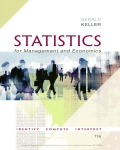
Concept explainers
a:
The difference between the two population means.
a:
Explanation of Solution
The unequal variance estimator (v) can be calculated as follows:
The value of unequal variance is 64.8.
The difference between the two population means (DP) can be calculated as follows:
The difference between the two population means lies between -1.59 and 7.59.
b:
The difference between the two population means with increasing standard deviation.
b:
Explanation of Solution
The unequal variance estimator (v) can be calculated as follows:
The value of unequal variance is 63.1.
The difference between the two population means (DP) can be calculated as follows:
The difference between the two population means lies between -7.08 and 13.08.
c:
The impact of increasing standard deviation.
c:
Explanation of Solution
When the standard deviation increases, it increases the difference in the interval.
d:
The difference between the two population means with increasing
d:
Explanation of Solution
The unequal variance estimator (v) can be calculated as follows:
The value of unequal variance is 131.
The difference between the two population means (DP) can be calculated as follows:
The difference between the two population means lies between -0.22 and 6.22.
e:
The impact of increasing sample size.
e:
Explanation of Solution
When the sample size increases, it reduces the difference in the interval.
Want to see more full solutions like this?
Chapter 13 Solutions
EBK STATISTICS FOR MANAGEMENT AND ECONO
- As indicated in the attached image, U.S. earnings for high- and low-skill workers as measured by educational attainment began diverging in the 1980s. The remaining questions in this problem set use the model for the labor market developed in class to walk through potential explanations for this trend. 1. Assume that there are just two types of workers, low- and high-skill. As a result, there are two labor markets: supply and demand for low-skill workers and supply and demand for high-skill workers. Using two carefully drawn labor-market figures, show that an increase in the demand for high skill workers can explain an increase in the relative wage of high-skill workers. 2. Using the same assumptions as in the previous question, use two carefully drawn labor-market figures to show that an increase in the supply of low-skill workers can explain an increase in the relative wage of high-skill workers.arrow_forwardPublished in 1980, the book Free to Choose discusses how economists Milton Friedman and Rose Friedman proposed a one-sided view of the benefits of a voucher system. However, there are other economists who disagree about the potential effects of a voucher system.arrow_forwardThe following diagram illustrates the demand and marginal revenue curves facing a monopoly in an industry with no economies or diseconomies of scale. In the short and long run, MC = ATC. a. Calculate the values of profit, consumer surplus, and deadweight loss, and illustrate these on the graph. b. Repeat the calculations in part a, but now assume the monopoly is able to practice perfect price discrimination.arrow_forward
- how commond economies relate to principle Of Economics ?arrow_forwardCritically analyse the five (5) characteristics of Ubuntu and provide examples of how they apply to the National Health Insurance (NHI) in South Africa.arrow_forwardCritically analyse the five (5) characteristics of Ubuntu and provide examples of how they apply to the National Health Insurance (NHI) in South Africa.arrow_forward
 Managerial Economics: Applications, Strategies an...EconomicsISBN:9781305506381Author:James R. McGuigan, R. Charles Moyer, Frederick H.deB. HarrisPublisher:Cengage Learning
Managerial Economics: Applications, Strategies an...EconomicsISBN:9781305506381Author:James R. McGuigan, R. Charles Moyer, Frederick H.deB. HarrisPublisher:Cengage Learning







